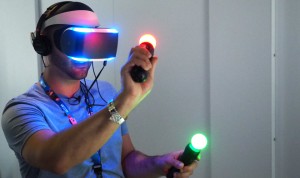When I initially chose this topic, I wanted to know the type(s) of treatment(s) that were most effective in healing soldiers returning home from war with mental wounds. I have always been fascinated with events pertaining to combat, which is why I was so drawn to this issue. Both of my grandfathers are war veterans, and have shared vivid stories from battle with the family, and the lasting impact (both negative and positive) the memories left behind. However, I was unaware of the specifics that factored into the treatment process and/or what type(s) of treatment they received. After pursuing the internet, I discovered a unique type of treatment, known as Virtual Reality, that has not been widely promoted just yet.
In reality, there is no real homecoming for veterans. During their attempt to rejoin civilian life, the memories from combat linger in the back of their minds, hindering their progress. The indescribable horrors of war leave a negative lasting impact on a number of today’s finest young people, ultimately resulting in a mental health condition recognized as Post Traumatic Stress Disorder (PTSD). By definition, PTSD is a psychological disorder that sprouts from a first-hand experience of a traumatic event. Those whom suffer from PTSD recall the vivid experiences frequently and have difficulty overcoming them. Some of the symptoms include trouble sleeping, being extra alert and aware, dependency on alcohol, flashbacks of the traumatic event, and acts of violence. If a soldier were to return home in this disheveled manner, they would typically be prescribed antidepressants, however, my research shows that this approach is ineffective in healing those who are physically and emotionally scarred.
The Study:
In order to determine how effective exposing soldiers with PTSD to virtual reality is in the healing process, Rothbaum, Hodges. Alarcon, Ready, Shahar, Graap, Pair, Hebert, Gotz, Wills, and Baltzell (1999) conducted three controlled studies utilizing a caucasian, 50 year old male veteran who previously worked as a helicopter pilot in Vietnam and has suffered from depression, alcohol abuse, and PTSD. The coordinators administered the experiment by exposing the patient to computer animated scenarios that replicated his area of deployment. These animations were intended to imitate realistic situations that the soldier has experienced in the field, and allow him to train his responses and restore memories.
Conclusion: Through their initial analysis, Rothbaum, Hodges, Alarcon, Ready, Shahar, Graap, Pair, Hebert, Gotz, Wills, and Baltzell found that there was a significant decrease in the patient’s scores from pretreatment to posttreatment. During pretreatment the impact of event scale, ranging from zero to fifty, measured the level of distress caused on the veteran by the traumatic event a thirty three. In the six month follow up his score was a zero, showing a total absence of intrusive and avoidance symptoms related back to the traumatic event. The experimenters concluded that the sound of helicopters triggered the strongest emotions in the patient. Imaginal exposure is seen to be helpful in curing this because of its capability to vividly rehash the worst experiences and control the feelings they trigger.
Bottom line: Adequate and immediate psychotherapy treatment is necessary for soldiers returning home from combat, because an acute episode can eventually transition into a chronic lifelong issue. Not all soldiers suffer from PTSD, but those who do ultimately have trouble transitioning back into civilian life. The virtual reality exposure tested in this study shows positive results and holds potential for the future.
References:


